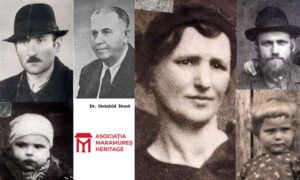Comunitatea evreilor din Berbești, Maramureș
În anul 1735 în satul Berbești trăia o familie de evrei care avea șase copii. În decurs de 100 de ani, mai exact în anul 1840, comunitatea evreilor număra 141 de persoane, aceștia reprezentau aproximativ 12% din totalul populației.Cei mai mulți evrei au fost consemnați în anul 1910, mai exact 568 de suflete, iar la ultimul recensământ aceștia era în număr de 508 persoane.
Toți evreii din localitate și-au declarat limba maternă limba idiș. Majoritatea evreilor erau agricultori sau mici comercianți. Cu toții erau evrei hașizi de Vijnița sau Sighet.
Comunitatea propiru zisă s-a înființat în anul 1850 când au construi o sinagogă din lemn și o casă de învățătură. În 1859 își aleg și primul rabin în persoana lui Iacov Teitelbaum. Acesta rămâne rabin până în anul 1890 când ginerele său, Rafael Grosz, vine în locul lui. Ultimul rabin al comunității a fost Leopold Grosz care supraviețuiește Holocaustului, dar în anii 1950 emigrează în Israel.
În vara anului 1941 autoritățile maghiare au declarat apatride aproximativ șase familii și i-au deportat în Galiția. În iarna anului 1941, 50 de bărbați evrei au fost mobilizați în departamentele de muncă forțată ale armatei maghiare și trimiși pe frontul de Est. Majoritatea au murit acolo.
Evreii din Berbești au fost ghetoizați de jandarmeria maghiară și armata germană în anul 1944. În ghetoul din Berbești au stat în condiții inumane aproximativ 3000 de evrei din Berbești și alte 19 localități pentru aproximativ o lună de zile. Bătăile și torturile au fost la ordinea zilei. În 17 mai 1944 au foști mutați cu toții în Sighetu Marmației, iar în ziua următoare au fost îmbarcați în trenuri spre Auschwitz-Birkenau. Au fost uciși aproape cu toții.
După război au revenit în localitate aproximativ 100 de evrei, însă aceștia au emigrat treptat, iar azi în Berbești nu mai trăiește nici un evreu.
1735-ben már élt Bárdfalván(ma Máramaros megye, Románia) egy zsidó család, amelynek hat gyermeke volt. 100 év alatt, pontosabban 1840-ben a zsidó közösség 141 főt számlált, ők az összlakosság mintegy 12%-át tették ki. A legtöbb zsidót 1910-ben jegyezték fel, pontosan 568 lelket, a legutóbbi népszámláláskor, 1941-ben pedig 508 főt.
Maga a közösség 1850-ben alakult, amikor egy fából készült zsinagógát és egy tanházat építettek. 1859-ben megválasztották első rabbijukat is Iacov Teitelbaum személyében. 1890-ig rabbi marad, amikor veje, Grosz Rafael lép a helyére. A közösség utolsó rabbija Leopold Grosz volt, aki túlélte a Holokausztot, de az 1950-es években Izraelbe emigrált.
A helységben élő összes zsidó a jiddist jelölte meg anyanyelvének. A legtöbb zsidó földműves vagy kiskereskedő volt. Mindannyian szigeti vagy vizsnicai haszid zsidók voltak.
1941 nyarán a magyar hatóságok mintegy hat családot hontalanná nyilvánítottak és Galíciába deportáltak. 1941 telén 50 zsidó férfit mozgósítottak a magyar hadsereg kényszermunka osztályaira és a keleti frontra küldtek. A legtöbben ott haltak meg.
A bárdfalvi zsidókat 1944-ben gettóba zárta a magyar csendrőrség és a német hadsereg. A bárdfalvi és további 19 helységből származó zsidók, mintegy 3000 zsidó egy hónapig maradtak itt. A zsidókat mindennap verték és kinózták. 1944. május 17-én mindannyiukat Máramarosszigetre hurcoltak, másnap pedig Auschwitz-Birkenauba deportálták őket. Majdnem mindegyiküket ott gyilkolták meg.
A háború után mintegy 100 zsidó tért vissza a faluba, de fokozatosan kivándoroltak, és ma már nem él zsidó Bárdfalván.
In 1735, a Jewish family lived in the village of Berbești(Maramureș county, Romania today), which had six children. Within 100 years, precisely in 1840, the Jewish community numbered 141 people, they represented approximately 12% of the total population. The most Jews were recorded in 1910, precisely 568 souls, and at the last census they were 508 people.
All the Jews in the locality declared Yiddish as their mother tongue. Most Jews were farmers or small traders. They were all Hasidic Jews from Vijnita or Sighet.
The community itself was founded in 1850 when they built a wooden synagogue and a house of learning. In 1859 they also chose their first rabbi in the person of Iacov Teitelbaum. He remains rabbi until 1890 when his son-in-law, Rafael Grosz, comes in his place. The last rabbi of the community was Leopold Grosz who survived the Holocaust but emigrated to Israel in the 1950s.
In the summer of 1941, the Hungarian authorities declared about six families stateless and deported them to Galicia. In the winter of 1941, 50 Jewish men were mobilized into the forced labor departments of the Hungarian army and sent to the Eastern Front. Most died there.
The Jews of Berbești were ghettoized by the Hungarian gendarmerie and the German army in 1944. In the Berbești ghetto, approximately 3,000 Jews from Berbești and 19 other localities stayed in inhumane conditions for approximately one month. Beatings and torture were the order of the day. On May 17 1944, they were all moved to Sighetu Marmației, and the next day they were put on trains to Auschwitz-Birkenau. Almost all of them were murdere there.
After the war, approximately 100 Jews returned to the town, but they gradually emigrated, and today there is no Jew living in Berbești.




Info YadVashem




